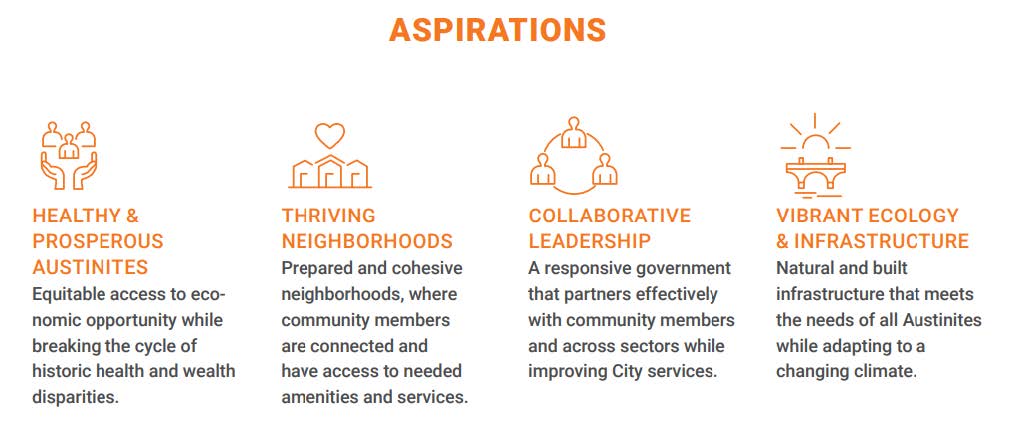As the City of Austin’s first chief resilience officer, Laura Patiño ensures Austinites have means to thrive and adapt in any circumstance.
By Brandi Clark Burton, Photo courtesy of City of Austin
Laura Patiño moved to Austin from Houston 18 months ago. In that time, she has experienced the fact that despite being one of the hottest (pun intended) cities to live in, Austin is not immune to acute shocks such as floods, freezes, fires, destructive storms, brownouts and extreme heat. But Patiño came here with eyes wide open, because she was hired to be the City of Austin’s first chief resilience officer.

In her role, she helps build the city’s capacity to manage, prepare for and withstand risk, as well as residents’ ability to adapt and thrive, no matter what kind of disasters and day-to-day challenges threaten our way of life. While Austin continues to experience the impacts of climate change, our population continues to rise, placing additional stresses on land and water resources, city systems and infrastructure, and the economy.
In Patiño’s time here, she has worked to weave the city’s values and existing plans into the development of a resilience blueprint report. The three cross-cutting priorities of addressing climate change, increasing affordability and advancing racial equity need to be addressed in an integrated way. This fall kicks off a robust community engagement process leading up to the release of the Comprehensive Resilience Plan next summer, and all are invited to get involved.
Patiño has built on a program initially started by the Office of Sustainability called the Resilience Hub Network. With six active pilot locations, the goal is to establish a distributed network of trusted spaces that strengthen community ties and provide services before, during and after a disaster. On a day-to-day basis, they can serve as information centers, refuge for heating or cooling, potential shelter and even food and water supplies.

MINDSET SHIFT: Be prepared, not surprised.
Steps to Prep
Three of the greatest climate risks to Central Texas are floods, fires and extreme weather (heat and ice). In the name of us all being survivors, here are priority actions you can take to prevent, be prepared for and thrive before and after emergencies arise.
General Preparedness
Get familiar with local weather patterns, flood-prone zones and wildfire-vulnerable areas. Every household should establish an emergency plan with meeting spots, communication strategies and roles assigned to everyone.
Make sure you get emergency alerts by registering at warncentraltexas.org.
The Office of Resilience, in partnership with the Homeland Security and Emergency Management Office and community partners, has developed a Neighborhood Preparedness Guide for facing all climate hazards:
Floods
Central Texas was known as Flash Flood Alley even before this new weather trend of extended drought punctuated by rain bombs. It will continue to get worse as our population doubles again in the next 30 years and development covers more natural landscapes. What can you do?
Monitor atxfloods.com during rain events to see low-water crossing and road closures. Remember, “Turn Around, Don’t Drown!”
Vehicles can be swept away in just 12 inches of floodwater. Just six inches of fast-moving water can knock over an adult.
Fires
Currently 49% of structures in Austin are in the wildland urban interface and face greater wildfire risk. As we grow even more, housing will be built in high-risk areas.
Do a Firewise assessment of your home and workplace. Go to fireadapted.org to learn about strategies to fireproof homes and businesses. At a minimum, clear away dry vegetation, install (and regularly test) smoke detectors and have fire extinguishers on hand.
Consider organizing a neighborhood fire drill, first championed by Travis County Commissioner Brigid Shea after the Steiner Ranch fires.
MINDSET SHIFT: Think as a community, not as an individual, in the event of emergencies.
Extreme Heat and Freezing
Heat is the most detrimental climate impact that has led to more deaths than any other climate disaster in Austin. More people die of heat than they do of floods, cold weather or wildfire smoke. The city is developing Austin’s first Heat Resilience Playbook for release this fall. This is where community resilience comes in. Seek out and especially make sure that vulnerable neighbors or unhoused people know about and can access the network of cooling centers offering refuge for many during the blistering heat as well as in freezes. These will be bolstered by the growing network of Resilience Hubs.

